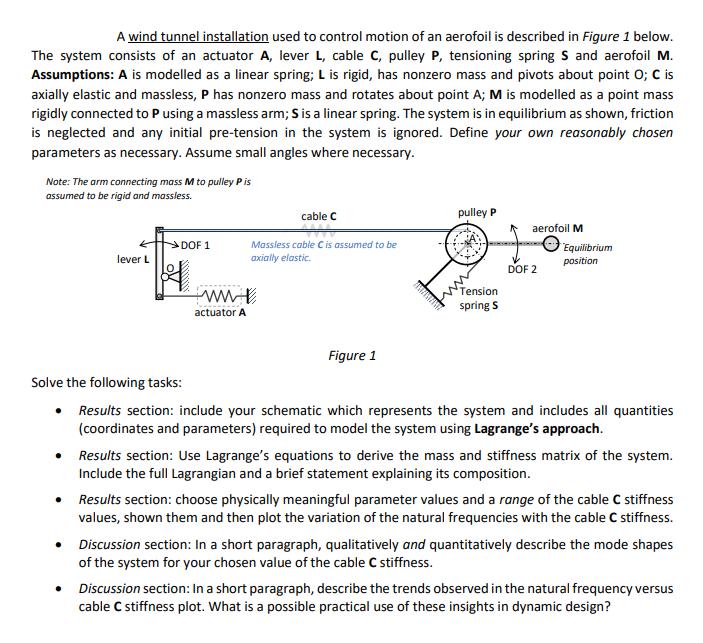Answered step by step
Verified Expert Solution
Question
1 Approved Answer
A wind tunnel installation used to control motion of an aerofoil is described in Figure 1 below. The system consists of an actuator A,

A wind tunnel installation used to control motion of an aerofoil is described in Figure 1 below. The system consists of an actuator A, lever L, cable C, pulley P, tensioning spring S and aerofoil M. Assumptions: A is modelled as a linear spring; L is rigid, has nonzero mass and pivots about point O; C is axially elastic and massless, P has nonzero mass and rotates about point A; M is modelled as a point mass rigidly connected to P using a massless arm; S is a linear spring. The system is in equilibrium as shown, friction is neglected and any initial pre-tension in the system is ignored. Define your own reasonably chosen parameters as necessary. Assume small angles where necessary. Note: The arm connecting mass M to pulley P is assumed to be rigid and massless. lever L DOF 1 . ww actuator A cable C Massless cable C is assumed to be axially elastic. Figure 1 AMAHAHA pulley P Tension spring S aerofoil M DOF 2 Equilibrium position Solve the following tasks: Results section: include your schematic which represents the system and includes all quantities (coordinates and parameters) required to model the system using Lagrange's approach. Results section: Use Lagrange's equations to derive the mass and stiffness matrix of the system. Include the full Lagrangian and a brief statement explaining its composition. Results section: choose physically meaningful parameter values and a range of the cable C stiffness values, shown them and then plot the variation of the natural frequencies with the cable C stiffness. Discussion section: In a short paragraph, qualitatively and quantitatively describe the mode shapes of the system for your chosen value of the cable C stiffness. Discussion section: In a short paragraph, describe the trends observed in the natural frequency versus cable C stiffness plot. What is a possible practical use of these insights in dynamic design? A wind tunnel installation used to control motion of an aerofoil is described in Figure 1 below. The system consists of an actuator A, lever L, cable C, pulley P, tensioning spring S and aerofoil M. Assumptions: A is modelled as a linear spring; L is rigid, has nonzero mass and pivots about point O; C is axially elastic and massless, P has nonzero mass and rotates about point A; M is modelled as a point mass rigidly connected to P using a massless arm; S is a linear spring. The system is in equilibrium as shown, friction is neglected and any initial pre-tension in the system is ignored. Define your own reasonably chosen parameters as necessary. Assume small angles where necessary. Note: The arm connecting mass M to pulley P is assumed to be rigid and massless. lever L DOF 1 . ww actuator A cable C Massless cable C is assumed to be axially elastic. Figure 1 AMAHAHA pulley P Tension spring S aerofoil M DOF 2 Equilibrium position Solve the following tasks: Results section: include your schematic which represents the system and includes all quantities (coordinates and parameters) required to model the system using Lagrange's approach. Results section: Use Lagrange's equations to derive the mass and stiffness matrix of the system. Include the full Lagrangian and a brief statement explaining its composition. Results section: choose physically meaningful parameter values and a range of the cable C stiffness values, shown them and then plot the variation of the natural frequencies with the cable C stiffness. Discussion section: In a short paragraph, qualitatively and quantitatively describe the mode shapes of the system for your chosen value of the cable C stiffness. Discussion section: In a short paragraph, describe the trends observed in the natural frequency versus cable C stiffness plot. What is a possible practical use of these insights in dynamic design?
Step by Step Solution
★★★★★
3.33 Rating (153 Votes )
There are 3 Steps involved in it
Step: 1

Get Instant Access to Expert-Tailored Solutions
See step-by-step solutions with expert insights and AI powered tools for academic success
Step: 2

Step: 3

Ace Your Homework with AI
Get the answers you need in no time with our AI-driven, step-by-step assistance
Get Started


